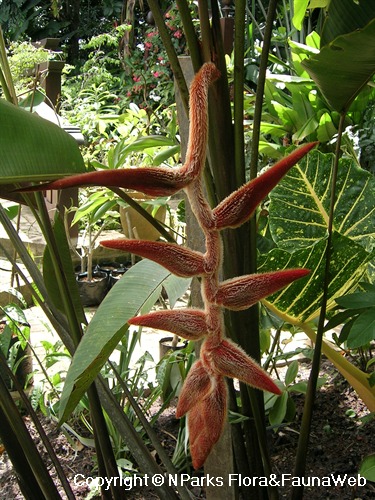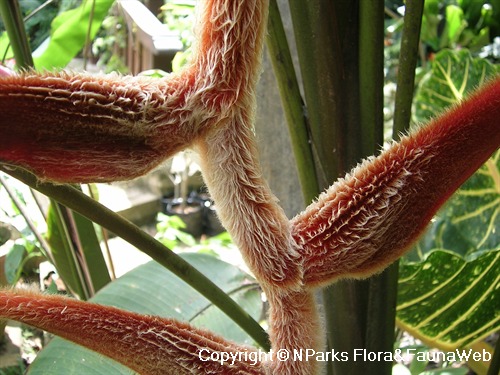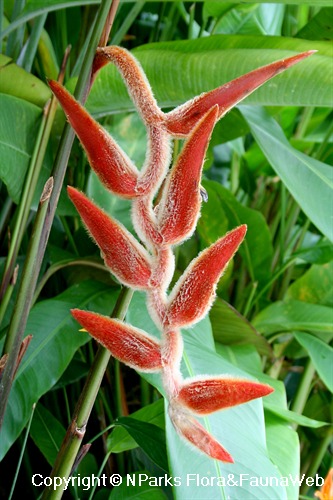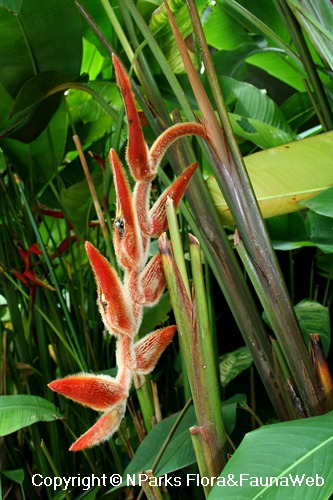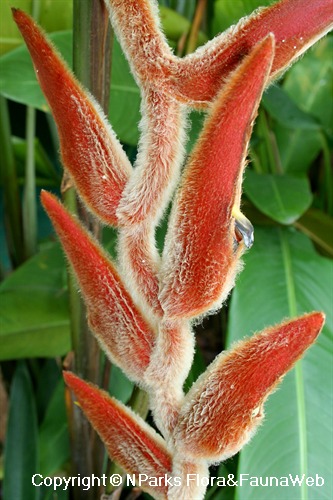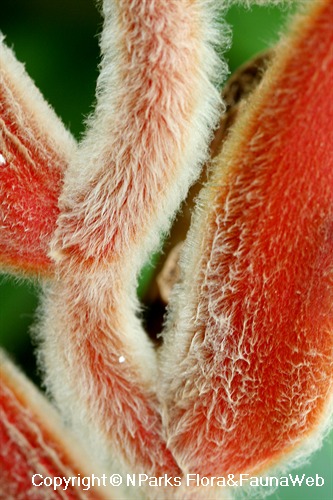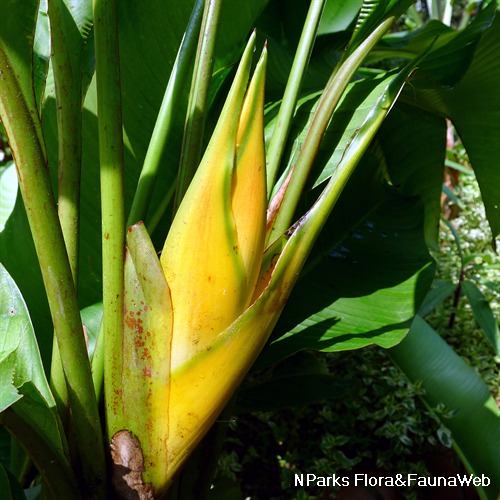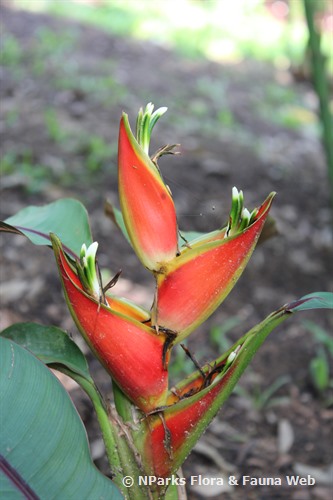Back
Heliconia vellerigera Poepp.
| Family Name: | Heliconiaceae |
| Synonyms: | Bihai vellerigera (Poepp.) Kuntze |
| Common Name: | Furry Heliconia, King Kong Heliconia, Donkey's tail |
The Furry Heliconia (Heliconia vellerigera) is a tall, clump-forming rhizomatous herbaceous plant with large, banana-like leaves, tinged with a bronze underside. This ginger-relative makes for a great focal plant in landscaping due to its distinct inflorescence with woolly bracts and rachis, and non-descript tubular, yellow flowers.
Name
Classifications and Characteristics
| Plant Division | Angiosperms (Flowering Seed Plants) (Monocotyledon) |
|---|---|
| Plant Growth Form | Herbaceous Plant |
| Lifespan (in Singapore) | Perennial |
| Mode of Nutrition | Autotrophic |
| Maximum Height | 1.8 m to 3.0 m |
Biogeography
| Native Distribution | Colombia, Ecuador, Peru |
|---|---|
| Native Habitat | Terrestrial (Primary Rainforest) |
| Preferred Climate Zone | Tropical, Highland / Montane |
| Local Conservation Status | Non-native (Horticultural / Cultivated Only) |
Description and Ethnobotany
| Growth Form | It is a clump-forming, rhizomatous herbaceous plant that grows up to 3 m tall. |
|---|---|
| Foliage | The leaves are broadly oblong, reaching 0.75 - 1.5 m long by 0.2 - 0.5 cm wide. The upperside is green while the undersides are usually bronze in colour. |
| Stems | The pseudostems is formed by the tighly-overlapping leaf sheaths. The true stems are underground rhizomes (thick, horizontal modified stems). |
| Flowers | The inflorescence is a pendulous panicle with up to 20-30 bracts. The bracts and rachis (main stem of inflorescence) are reddish-brown and covered in long woolly hairs. Each bracts subtends a cluster of hook-like, tubular, waxy, yellow flowers. |
| Fruit | The fruits are small oblongoid drupes that turn deep-blue to purple when ripe. |
| Habitat | It can be found in tropical lowland to montane rainforests. |
| Associated Flora | In its native habitat, the flowers are pollinated by hummingbirds. |
| Cultivation | This species grows best in full sun to semi-shaded conditions, and moist but well-draining soil with plenty of organic material. Avoid waterlogged soil as it is prone to fungal attack and rot. It can be propagated by seeds, division, and suckers. |
| Etymology | The genus Heliconia is named after Mount Helicon in Greece, the supposed home of Apollo and the mythological Muses. The specific epithet vellerigera is Latin for velleris genitive of vellus, meaning "fleece, wool" and gero, meaning "carrier" in reference to the fluff covering rachis and bracts of the inflorescence. |
Landscaping Features
| Desirable Plant Features | Ornamental Flowers, Ornamental Form |
|---|---|
| Landscape Uses | General, Flowerbed / Border, Parks & Gardens, Focal Plant |
| Thematic Landscaping | Naturalistic Garden |
Fauna, Pollination and Dispersal
| Fauna Pollination Dispersal Associated Fauna | Bird-Attracting (Flowers) |
|---|---|
| Pollination Method(s) | Biotic (Fauna) (Vertebrates (Bird)) |
| Seed or Spore Dispersal | Biotic (Fauna) |
Plant Care and Propagation
| Light Preference | Semi-Shade, Full Sun |
|---|---|
| Water Preference | Moderate Water |
| Plant Growth Rate | Moderate |
| Rootzone Tolerance | Fertile Loamy Soils, Well-Drained Soils |
| Maintenance Requirements | Moderate |
| Pest(s) | Sucking Insects, Soil Insects |
| Propagation Method | Sucker, Division, Seed |
Foliar
| Foliage Retention | Evergreen |
|---|---|
| Mature Foliage Colour(s) | Green, Brown |
| Mature Foliage Texture(s) | Smooth |
| Foliar Modification | Flower/Fruit Bract |
| Foliar Type | Simple / Unifoliate |
| Foliar Arrangement Along Stem | Equitant |
| Foliar Attachment to Stem | Petiolate |
| Foliar Shape(s) | Non-Palm Foliage (Oblong) |
| Foliar Venation | Pinnate / Net |
| Foliar Margin | Entire |
| Foliar Apex - Tip | Acute, Acuminate |
| Foliar Base | Cordate |
| Typical Foliar Area | Macrophyll ( 182.25cm2 - 1640.25 cm2 ) |
| Leaf Area Index (LAI) for Green Plot Ratio | 3.5 (Shrub & Groundcover - Monocot) |
Non - Foliar and Storage
| Stem Type & Modification | Shortened Internodes, Herbaceous |
|---|---|
| Root Type | Underground (Fibrous Root) |
| Specialised Storage Organ(s) | Underground (Rhizome) |
Floral (Angiosperm)
| Flower & Plant Sexuality | Bisexual Flowers |
| Flower Colour(s) | Brown, Red, Yellow / Golden |
|---|---|
| Flower Texture(s) | Waxy |
| Flower Grouping | Cluster / Inflorescence |
| Flower Location | Terminal |
| Flower Symmetry | Bilateral |
| Individual Flower Shape | Tubular |
| Inflorescence Type | Panicle |
| Flowering Period | Free-Flowering |
| Flower Lifespan on Plant | Several Days |
| Flowering Habit | Polycarpic |
Fruit, Seed and Spore
| Mature Fruit Colour(s) | Blue, Purple |
|---|---|
| Mature Fruit Texture(s) | Leathery |
| Fruit Classification | Simple Fruit |
| Fruit Type | |
| Mature Seed Colour(s) | Black |
| Seed Quantity Per Fruit | Few (1-5) |
References
| References | Heliconia vellerigera Poepp., Flora of Panama (WFO),Tropicos.org, Missouri Botanical Garden, 2012. (Accessed 19 February 2025) |
|---|
Image Repository
Others
| Master ID | 789 |
|---|---|
| Species ID | 2084 |
| Flora Disclaimer | The information in this website has been compiled from reliable sources, such as reference works on medicinal plants. It is not a substitute for medical advice or treatment and NParks does not purport to provide any medical advice. Readers should always consult his/her physician before using or consuming a plant for medicinal purposes. |

